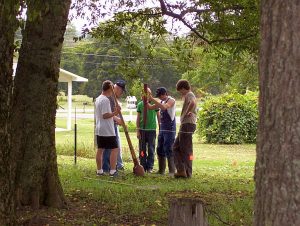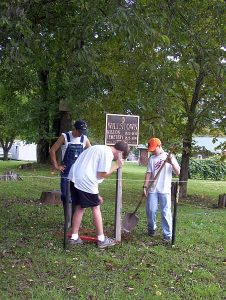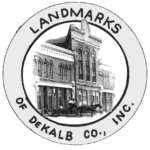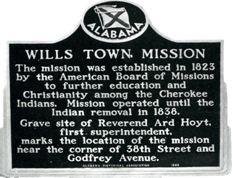
The Wills Towne Mission was established in 1823
In 1823 the American Board of Commissioners for Foreign Missions chose this site for its fifth mission/school for the Cherokees. The Boston-based organization had established its initial mission at Brainerd near present Chattanooga, in 1819. Among the influential Cherokees who persuaded the officials at Brainerd to establish a mission/school here were John Ross and his brother Andrew, and George Lowery.
A ten acre plot of land was purchased by the board for the mission/school which was located on the main road from Ross’ Landing to Willstown. Separate log structures 18 by 20 feet were constructed for use as classrooms by the boys and girls. Other buildings included a two story log house for the missionaries, six cabins for the students who boarded, a smokehouse, two corn cribs, a spring house, and a gristmill. Water came from a cave a few hundred yards away, and a clever wooden trough provided fresh water for the students and their teachers. The missionaries’ house was located two houses down this street. A large stone larder still survives. The property was the reported site of the Council Tree where Cherokees from around the area gathered to hold council meetings. The old tree died in the 1950’s and Landmarks planted a replacement in 1983. The tree and marker are near the street at 3707 Godfrey Avenue.
Missionary/teachers here included Rev. and Mrs. William Chamberlain, Rev. and Mrs. Ard Hoyt, and Rev. Daniel Butrick. Mr. and Mrs. Sylvester Ellis were employed as farmers. Classes began on May 12, 1823 for students who lived within walking distance of the school, and boarding students were admitted a little later. The school was free of charge except for students who boarded there.
The cemetery may predate the mission/school. A local legend claims that many Cherokee, including John Watts, the Chickamauga warrior, are buried here, but this has not been substantiated. The cemetery was also used as a flower garden by the missionaries, and it was here that Ard Hoyt was buried in February of 1828 after suffering from an unknown illness. His funeral drew a large number of Cherokees, friends and admirers. Born in Danbury, Connecticut in 1790, the Cherokees called him “father” Hoyt. Some members of his family, including sons Darius and Milo, continued to work as teachers and missionaries for the Cherokees.
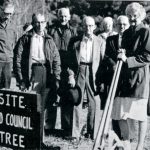 In 2006, Landmarks received the cemetery property as a gift from Winnie Larmore Scott whose ancestors are buried there. New fencing was installed in 2009 as an Eagle Scout project by Jared Hurley with the assistance of his fellow scouts in Troop 106.
In 2006, Landmarks received the cemetery property as a gift from Winnie Larmore Scott whose ancestors are buried there. New fencing was installed in 2009 as an Eagle Scout project by Jared Hurley with the assistance of his fellow scouts in Troop 106.
Landmarks is grateful to Winnie Larmore Scott for donating the historic Willstown Cemetery to Landmarks. She presented the deed to past President Perry Morgan, knowing that he was a dedicated historian and would set in motion the plans for maintaining and preserving the cemetery. Thank you, Winnie. In memory of Perry, Landmarks is already working on the plan. And, all of Fort Payne owes Elizabeth Howard a debt of gratitude for researching and documenting the history of Willstown and the cemetery so that it will not be lost to history.
 The Willstown Mission Cemetery Site has been certified by the National Park Service as an official component of the Trail of Tears National Historic Trail. The congressionally designated trail commemorates the tragic history of the removal of the Cherokee people from their ancestral homelands to territory in the West. Landmarks of DeKalb County is pleased to be in partnership with the National Park Service to preserve, interpret and make this historic property available to the public.
The Willstown Mission Cemetery Site has been certified by the National Park Service as an official component of the Trail of Tears National Historic Trail. The congressionally designated trail commemorates the tragic history of the removal of the Cherokee people from their ancestral homelands to territory in the West. Landmarks of DeKalb County is pleased to be in partnership with the National Park Service to preserve, interpret and make this historic property available to the public.
There are over 50 obvious graves at the cemetery, but the archaeologists suspect there are many more and only 9 are marked. Military Paymaster records at the National Archives have been found showing disbursements made to individuals for shrouds and coffins for 41 Cherokee Indians who died in camp at Fort Payne between June and September 1838. Could they have been buried at this cemetery?
An alphabetical list of the marked burials is below:
- Campbell, Sarah SEC of HB Campbell Born Oct 1847 Died 2 Aug 1869
- Hoyt, Ard born abt 1770 and died February 18, 1828
- Larmore, Elizabeth W. born 10 May 1842 and died 30 December 1847
- Larmore, Hugh P.C. born 20 Oct 1844 and diec 26 February 1866
- Larmore, John Vance born 17 Nov 1840 and died 21 Jun 1841
- Larmore, Laura I. born 16 May 1859 and died 21 Feb 1874
- Larmore, Margaret M. born 1 May 1819 and died 4 June 1898
- Larmore Vance C. born 13 Mar 1809 and died 28 Jan 1886
- Unknown, AT REST – 3 children
The gravestone for the children that simply says “AT REST —3 children” has a hand with a pointing finger and the word “EAST”. The stone has been broken off and moved, so no one knows where in the cemetery it originally was. There are many unanswered questions associated with this cemetery. If anyone has information they would like to share, please contact Landmarks at (256) 845-6888 or send us an email: LANDMARKS
The other two certified properties owned by Landmarks of DeKalb County are the Cabin Site located off 4th St. SE, which is open by appointment only, and the Andrew Ross Home, also known as the Cherokee Plantation, a private home now owned by Dr. Brewer and not open to the public.
For further information, contact Landmarks at (256) 845-6888 or send email to: LANDMARKS
